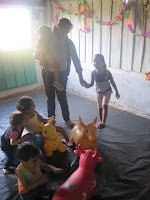"They call this Soya road," Fernando tells us as we drive, vast plains on either side of us. "2.5 million hectares owned by less than 1000 people." It is the largest plantation in a country becoming quickly covered with Soya monocultures. Land concentration into the hands a few producers (most of whom are Brazillian we are told) has been one factor that has vaulted Paraguay into the 10 ten soy exporters in the world. Despite the wealth being created, the country remains one of the poorest in Latin America. This is development for the rich, not the poor and the common good. It is for this reason that one of D&P's two axes in our
Paraguay program is
"Training community leaders who are in a position to set up sustainable development models." The emphasis here being on sustainable.
 |
| Co-op store in Limoy |
 |
| Passing on the Culture in O'Leary |
Our van heads off the main road into the sea of soy
, which has recently been harvested. For three days we travel with our partner, the
Movimento Campesino Paraguayo (
MCP), visiting several Campesino communities who make up a small part of their movement.
MCP is present in 14 or Paraguay's 17 departments (a department being the equivalent of a Canadian Province) and is made up of fourteen thousand families. These communities are like islands, small pieces of inhabited land surrounded by massive monocultures.
 |
| Community Radio in San Isidro |
 |
| Child-care in Santo Catolina |
 |
| Finding a home in Santiago Martinez |
We visit the communities of Limoy (the oldest
MCP settlement dating back to the mid-80's), Santiago Martinez, O'Leary, San Isidro and Santa Catalina. I feel each time we leave a place that I am taking a hundred stories to tell in my pocket. Co-operatives, radio stations, schools, and the constant struggle to gain access to a small piece of land to call their own - these are the experiences our hosts from the movement share with us and which in subsequent posts, I'll try to give a sampling for you.










2 comments:
Hello to all the members of your group, Luke. Your blog entries and photos are great.
Today's blog entry touches on the heart of our 2011 Fall Campaign and it provokes lots of questions in my mind. What is the capacity for the Paraguayan farming community to feed its population if so much land is taken up with soybean production? Are there stats on food production? What does this mean for price and quality of food? Also, we will be looking at the capacity of small-scale farming practices to enhance soil quality. Small-scale farming not only increases quality and quantities of food, but it helps to mitigate climate change. What is happening to the quality of the soil with this massive production of soybeans?
Thank-you again for sharing your travels with us,
Armella
I'm looking into working with axis soybean seeds in Waseca, MN. It's incredible to me how they grow all over the world. Soy is such a useful plant.
Post a Comment